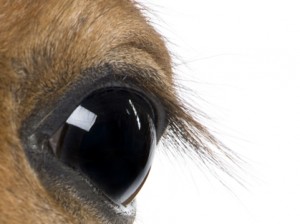Pet Talk: Eye Injuries in Horses—Something to Look Out For
Press release courtesy of Texas A&M University
Horses are known for their massive stature and majestic features. Everything from their muscular physique to their large, lovely eyes leaves us in awe. However, just as horses can injure their joints and muscles quite easily, ocular trauma is common due to their eyes’ unique size and shape, and can become dangerous if not treated quickly.
“There are several features of the equine eye that makes it quite vulnerable to injury and anatomical features of the equine skull that contribute to this increased risk for injury,” said Dr. Leslie Easterwood, Assistant Clinical Professor at the Texas A&M College of Veterinary Medicine & Biomedical Sciences. “The equine head features a complete bony orbital rim and globes that protrude on each side, leaving the eyes vulnerable to injury.”
Ocular injuries in horses should not be taken lightly. If you suspect that your horse is showing signs of abnormality, it must be evaluated promptly and accurately. “Owners should be counseled to consider any abnormality involving the eye as cause for concern requiring prompt veterinary attention,” said Easterwood. “Owners should watch out for squinting, tearing, lid swelling, corneal opacity, and facial asymmetry.”
The first step you should take when evaluating a horse with ocular or orbital trauma is a complete physical examination. It is also important that their neurologic status is evaluated prior to considering sedation for the ocular examination. “Sedation in the face of an undiagnosed neurologic injury could result in a lowered threshold for seizures,” said Easterwood. “Owners will frequently miss subtle neurologic deficits and focus on obvious ocular trauma.”
Some of the common ocular emergencies in horses include eyelid lacerations, traumatic globe rupture, ulcerative corneal rupture with iris prolapse, fungal keratitis, and acute central blindness.
“Eyelid lacerations most commonly involve the upper lid, and course from the side to the middle,” said Easterwood. “These lacerations should be repaired with the goal to maintain lid architecture at all cost.” While these injuries are often easier to diagnose than most other eye emergencies, it is equally important to seek immediate medical attention.
Another frequent ocular injury, traumatic globe rupture, can commonly be caused from blunt force trauma to the globe. “Prompt surgical repair is essential to maintain sight, but be careful to avoid ophthalmic ointments if there is any chance of a globe rupture,” said Easterwood.
Corneal rupture due to bacterial and fungal keratitis can hold a much more guarded prognosis than traumatic globe rupture, and require prompt diagnosis as well as intensive therapy. A ruptured cornea can often result in blindness due to scar tissue in the eye that prevents light from getting to the back of the eye. Treatment for both bacterial and fungal disease must be vigorous.
Acute central blindness, another common ocular emergency in horses, may result from traumatic optic neuropathy. Horses that suffer from this may never be sighted, but can be maintained with appropriate therapy and management changes. “Permanently dialated pupils are a poor prognostic indicator,” said Easterwood. “Anti-inflammatory therapy for this should be initiated, but recovery is rare.”
It is vital that equine eye emergencies be evaluated promptly in order to start appropriate therapy. If ocular abnormalities go untreated, it is possible for there to be a permanent loss of sight. Just as we take the necessary precautions in preventing and treating injury to our own eyes, it is important that we do the same for our horses.
Pet Talk is a service of the College of Veterinary Medicine & Biomedical Sciences, Texas A&M University. Stories can be viewed on the Web at vetmed.tamu.edu/pettalk. Suggestions for future topics may be directed to editor@cvm.tamu.edu.











